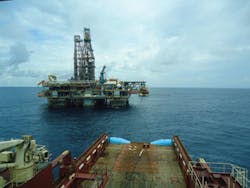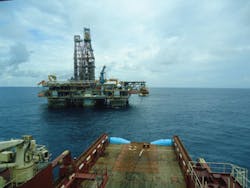Upstream News
InterMoor beats mooring depth record for Brazil
As part of a one-year project to provide mooring and positioning support operations for Shell do Brasil, InterMoor do Brasil Ltda (InterMoor), an Acteon company, has recently beaten the depth record for conventional mooring offshore Brazil with a water depth of 6,650 ft (2,027 m).
The project is for the mobile offshore drilling unit (MODU) Noble Clyde Boudreaux and will run until the middle of 2012. Operations focus on the Campos and Santos basins, but could be in any location off Brazil's southeast coast in water depths ranging from 1,968 to 7,545 ft (600 to 2300 m).
Andre Oliveira, project manager, InterMoor said, "We are committed to delivering safe, efficient and cost-effective mooring operations in support of this drilling campaign. There are challenges, so we have worked with Shell to plan everything in minute detail. This planning is essential if we are to continually break new boundaries such as the previous water depth record for conventional mooring offshore Brazil at 6,610 ft (2015 m) (well depth) and two of the eight anchors moored at 6,650 ft (2027 m)."
Noble Clyde Boudreaux
The contract covers the provision of engineering mooring analysis reports and conventional mooring. InterMoor designs mooring patterns for the Noble Clyde Boudreaux at every drilling rig location. This involves a mix of open-water exploration work and mooring around subsea assets.
InterMoor assisted Shell in defining the anchor-handling vessel specifications for the program based on the final mooring system design and supplies mooring coordinators, engineers and survey personnel on the rig and anchor-handling vessels to supervise and direct mooring system deployment, retrieval and connection to the rig. Because of the water depths and the high loads, the anchor-handling vessels are high power with bollard pulls of 265 Mt and are fitted with 9,842 ft (3000 m) work wires. The planning also considered the availability of mooring element spares as a critical measure to prevent unexpected major delays to operations. InterMoor also participates in planning workshops and advises Shell and Noble staff on mooring optimization.
"The contract, which was won in 2006 for the Arctic 1 MODU and varied in 2011 for the Noble Clyde Boudreaux, significantly underlines InterMoor's strong presence and rapid growth in Brazil," said Oliveira. "We have recently acquired a dockside area facility at Port of Açu in the northern part of Rio de Janeiro state. This will enable us to improve the logistics of future mooring and installation projects further."
Toyota Tsusho invests heavily in Alberta CBM play
Calgary-based Encana Corp. has reached an agreement with Toyota Tsusho Wheatland Inc., a subsidiary of Toyota Tsusho Corp., that will see the Japanese company invest approximately US$608 million to acquire a 32.5% royalty interest in natural gas production from a portion of Encana's coal-bed methane (CBM) resource play. The agreement includes production from a total of about 5,500 existing wells and potential future drilling locations in southern Alberta province.
"This investment from a global partner recognizes the significant value identified in Encana's CBM lands, which rank among the company's lowest-cost, lowest-risk assets, and signifies another step as Encana pursues a range of opportunities to manage its portfolio and enhance the long-term value creation of its vast inventory," said Randy Eresman, Encana president and CEO.
"Encana's CBM resources cover a great expanse that includes approximately 2.1 million net acres in the Horseshoe Canyon fairway. The vast majority of this acreage is fee lands, where Encana holds the mineral rights in perpetuity, and are estimated to contain significant amounts of recoverable natural gas."
Encana's CBM assets integrate CBM and the company's widespread shallow gas developments, including tapping into coal seams and sands using a combination of existing, new and recompleted wells. Under the agreement, Toyota Tsusho paid C$100 million with the closing of the transaction and will invest approximately C$502 million over seven years to acquire a 32.5% royalty interest, before deductions, in production from about 4,000 existing wells and around 1,500 potential future drilling locations. These wells are located in an area covering about 480,000 net acres along the eastern edge of the Horseshoe Canyon fairway - an area that represents about 24% of Encana's total CBM net acreage.
The existing wells on these lands are producing about 120 million cubic feet equivalent per day of natural gas. The area contains approximately 480 billion cubic feet equivalent (bcfe) of proved plus probable reserves and 140 bcfe of best estimate economic contingent resources as of Dec. 31, 2011. Under the agreement, Encana will be operator and Encana and Toyota Tsusho have established a management committee that will provide overall supervision and direction of development operations.
RBC Capital Markets and Jefferies & Company, Inc. are acting as financial advisors to Encana, and Burnet, Duckworth & Palmer LLP is acting as the firm's legal advisor.
CNOOC, Eni join hands again in South China Sea
China National Offshore Oil Corp. Ltd.'s parent company, China National Offshore Oil Corp., has signed a production sharing contract with Eni China BV (Eni) for the deepwater Block 30/27 in South China Sea.
Block 30/27, located 400 kilometers off the coast of Hong Kong with a total area of 5,130 square kilometers, is one of the blocks CNOOC offered for foreign cooperation in 2011.
According to the contract, Eni will conduct 3D seismic surveys and drill one exploration well in Block 30/27. All expenditures incurred will be borne by Eni. CNOOC Limited has the right to participate in up to 51% working interest in any commercial discoveries in the block.
Zhu Weilin, executive vice president of CNOOC Ltd. and general manager of its exploration department , commented," Oil and gas resources are rich in the deepwater South China Sea and are one of the main sources for the company's medium- and long-term development. By joining hands with Eni again, we wish a great success on the project."
Eni also has equity interest in Blocks 16/08 and 16/19 located in the South China Sea and is the operator in Block 28/20.
IHS issues report on Volcker Rule impact
How will the Volcker Rule affect oil and gas companies? The Volcker rule is a specific section of the Dodd-Frank Wall Street Reform & Consumer Protection Act intended to restrict certain kinds of speculative investments that do not benefit their customers.
Paul Volcker, 84, served as chairman of the Federal Reserve (1979-1987) under Presidents Carter and Reagan, and also chaired President Obama's Economic Recovery Advisory Board through January 2011. He argued that such speculative activity played a key role in the financial crisis of 2007-2010. The rule is often referred to as a ban on proprietary trading by commercial banks, whereby deposits are used to trade on the bank's personal accounts, although a number of exceptions to this ban were included in the Dodd-Frank law. The rule's provisions are scheduled to be implemented as a part of Dodd-Frank on July 21, 2012.
IHS on March 28 issued a new report, "The Volcker Rule: Impact on the US Energy Industry and Economy." The study looks at the long-term economic contributions of shale gas in terms of jobs, economic value, and government revenues through 2035, as well as the broader macroeconomic impacts on households and businesses.
The report examines the impact on segments of the energy industry if the services that rely on US banks were to be curtailed through the implementation of the Volcker Rule regulations in their current form.
While commodities markets were not the primary focus of the legislation, the specialized nature of much of the commodity risk management and intermediation services that banks provide to companies would nonetheless be seriously affected. The study examined segments of the upstream (independent natural gas producers), power and downstream (US East Coast petroleum market) sectors as a case study. Among the key findings:
- $7.5 billion reduction in natural gas investment resulting in $0.64 per million British thermal units (MMBTU) increase in natural gas prices
- $5.3 billion increase in power costs per year
- Increased likelihood that all currently announced refinery closures on US East Coast would be permanent
- 4 cents per gallon increase in US East Coast gasoline prices, equal to $2 billion per year in additional costs to the end-consumer
The potential overall economic impact:
- Payroll employment more than 200,000 lower, on an annual basis, than the base case for 2012-2016
- $34 billion (2005 dollars) lower US GDP in 2016
- Cumulative nominal federal tax receipts $12 billion lower than the base case for 2012-2016
The report was commissioned by Morgan Stanley.
CORRECTION
The article "Who Moved My Rig?", written by Alex Buehler and John Charwinsky of The Marshall-Teichert Group and published in the December 2011 issue of Oil & Gas Financial Journal, was updated with attribution to the article, "Surviving The Downturn, Preparing For The Future", by Alvarez & Marsal and published by O&GFI in December 2009, as a source for the study of rig mobilization.
More Oil & Gas Financial Journal Archives Issue Articles
View Oil and Gas Articles on PennEnergy.com

